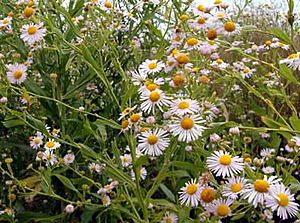Decurrent false aster facts for kids
Quick facts for kids Decurrent false aster |
|
|---|---|
 |
|
| Conservation status | |
| Scientific classification | |
| Kingdom: | |
| (unranked): | |
| (unranked): | |
| (unranked): | |
| Order: | |
| Family: | |
| Tribe: |
Astereae
|
| Genus: |
Boltonia
|
| Species: |
B. decurrens
|
| Binomial name | |
| Boltonia decurrens (Torr. & A.Gray) Alph.Wood
|
|
Boltonia decurrens is a special type of flowering plant. It is often called the decurrent false aster or claspingleaf doll's daisy. This plant is part of the aster family, which includes sunflowers and daisies.
This plant is very rare. It naturally grows in the floodplains along the Illinois and Mississippi Rivers in the United States. Sadly, the places where it lives have changed a lot. This has caused the plant's numbers to drop.
Contents
What is the Decurrent False Aster?
The decurrent false aster is a bushy plant that grows back every year. It can reach up to 1.5 meters tall, and sometimes even over two meters! Its leaves are unique because their bases extend down the stem. These leaves can be up to 15 centimeters long and are shaped like a line or a spear.
How Does It Look and Grow?
This plant has many flower heads that grow in a large cluster. Each flower head has white or light purple petals, called ray florets. These petals are about 1 to 2 centimeters long. In the middle of the flower, there are many small yellow disc florets.
The decurrent false aster blooms from August through October. It can make new plants in two ways. It can grow new shoots from its roots, which is called vegetative reproduction. It also makes seeds, which is called sexual reproduction.
Seeds and Floods
Each plant can produce a huge number of seeds, sometimes as many as 50,000! These seeds often travel on water, especially during floods. The plant is very good at living with floods. It can even grow underwater and still produce flowers and seeds above the surface. Its seeds sprout when they land on wet ground or even while floating in the water.
Where Does the Decurrent False Aster Live?
This plant used to grow along 400 kilometers of riverbanks. It stretched from LaSalle, Illinois, all the way to St. Louis, Missouri. Over time, people have changed the rivers and the land next to them. This has broken up the plant's habitat into about 20 smaller areas. Most of these areas are in Illinois.
For a while, people thought the plant had disappeared completely from Missouri. But since the mid-1980s, a few groups of these plants have been found near St. Louis again. Even though its numbers have gone down, some of these plant groups still have thousands of individual plants. The number of plants in an area can change a lot depending on how much and how long floods happen each year.
Why Is It an Endangered Species?
The decurrent false aster is listed as a threatened species by the government. This means it is at risk of disappearing forever.
Habitat Changes
Today, many areas next to the rivers are protected by flood control methods. This means natural flooding, which the plant needs, happens less often. The land has been changed into cropland. Marshes and prairies have been drained and plowed. Rivers are now controlled by levees and locks.
While the plant loves floods, its young plants need clear water with sunlight to grow. But now, floods often bring muddy water with lots of silt. This muddy water blocks the sunlight, and the plant cannot grow in it. Big floods have sometimes left thick layers of silt, which can destroy the plants.
Overgrowth and Human Help
Because natural flooding is less common, riverbanks can become overgrown with other plants. These plants create too much shade for the decurrent false aster. In some places, the plant now needs humans to help it. People might mow the area to clear away other plants. This helps the decurrent false aster, much like natural floods used to do.
How Are Its Populations Doing?
The size of the plant's groups changes depending on how much the area is disturbed, like by flooding. Some groups might have only one plant, while others can have a million or more! Sometimes, a group of plants might even disappear for a while.
After the Great Flood of 1993, many groups of the plant actually grew larger. The areas that were flooded the most severely saw the biggest increase in plants. Scientists have also studied the plant's genes. They found that the species has a lot of different genes, which is a good sign for its survival.


